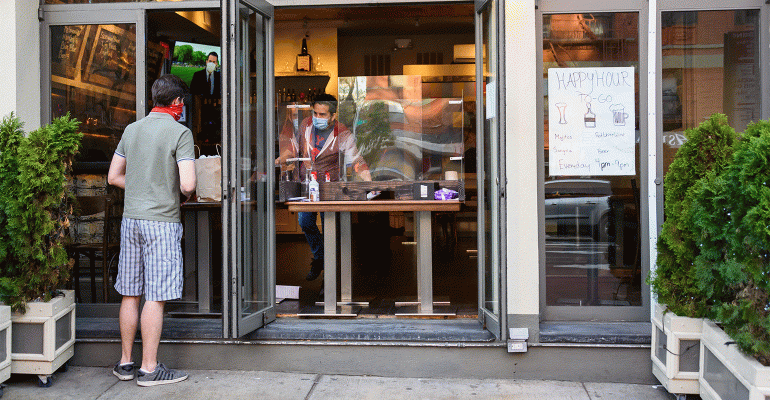The effects of the coronavirus pandemic have been devastating for the restaurant industry. April was the first month entirely affected by the stay-at-home guidelines and the results show it. Same-store sales for restaurants dropped by 55% during the month year over year, something unheard of for the industry in many decades. This update comes from Black Box Intelligence (formerly TDn2K) data from over 50,000 restaurant units and $75 billion in annual sales.
Same-store traffic for the month also dropped by 55%, as many consumers saw their daily routines upended, concern for the virus escalated at the national level and millions of Americans lost income due to the crisis.
“As bad as the results were in April, the latest Black Box Intelligence data suggests that the worst of the sales decline is behind us and we are now starting the long road towards recovery,” said Victor Fernandez, vice president of insights and knowledge for Black Box Intelligence. “During the last two weeks of March restaurants lost 67% of their sales year over year, but since then the decline in same-store sales improved by 20 percentage points. By the last two weeks of April sales decline slowed down to 47% year over year.”
“Obviously, we are still far from an ideal situation for the industry,” added Kelli Valade, CEO and president of Black Box Intelligence, “but the improvement in recent weeks is a testament to the resourcefulness and grit of restaurant operators who adapted and shifted quickly to this new restricted environment and have begun to turn things around.”
Limited-service brands fare best; fine and family dining hurt the most
As would be expected, brands that traditionally conduct a significant portion of their business through off-premise sales and have the lowest price points are best positioned to face the current challenges. By the last week of April, quick-service same-store sales were down less than 2% year over year. Fast casual sales were down by 30% by the last week of the month, having recovered by 20 percentage points from where they were at the end of March.
Those brands that rely more on dine-in experiences continue to navigate a much tougher scenario. By the last week of the month, full-service restaurants were still reporting lost sales of 62% year over year. Though much better than the 77% sales drop reported for the end of March, these are still problematic results for these companies.
Within the full-service sector of the industry, fine dining and family dining have been the segments hurt hardest by the pandemic. Their improvement over the last month is much smaller compared with the rest of the industry and they continue to see sales loss in the 75% to 85% range in recent weeks.
Guest checks grow rapidly for limited-service brands
As restaurant operations shifted toward off-premise only and limited service began capturing a bigger percentage of overall restaurant sales in recent weeks, an interesting phenomenon started occurring in relation to average guest check. While spending per guest decreased year over year for full-service brands, surely a reflection of lost beverage sales and probably also the impact of guests skipping pricier items or even reduced menu offerings, the opposite has been true for limited-service brands.
In the case of quick service, average check has been growing by almost 20% year over year during the last two weeks of April. The growth for fast casual also accelerated significantly at 16% for the same period.
Off-premise alcohol sales providing little lift for restaurants
So far, allowing restaurants to sell alcoholic beverages for off-premise consumption has had little positive impact on lost beverage sales in states where it has been authorized. For example, same-store beverage sales for casual dining in Texas, Nebraska, Arizona, Connecticut and California (states that allow off-premise alcohol sales and were the best performers on alcoholic beverage sales growth) were all within -92% to -94% for the last week of April. Although better than the -98% national change in alcoholic beverage sales for casual dining, this represents only marginal improvement.
Huge off-premise sales growth has not been enough
For full-service restaurants, which typically had less than 15% of their sales coming through off-premise, the shift caused by COVID-19 has meant massive growth in those channels. As restaurants have been focusing their efforts on expanding their off-premise offerings and consumers have started receiving some aid from stimulus checks and expanded unemployment benefits, combined sales growth in to-go, delivery and drive-thru topped 200% year over year by the end of April. The problem is, even this enormous growth is not enough to offset the huge hit from lost dine-in sales for concepts that were designed with that sit-down experience in mind.
For limited-service brands, it was already common for off-premise to represent more than half of their total sales, so sales growth has been much more moderate given the larger base. But even these brands are reporting to-go, delivery and drive-thru sales growing at a pace nearing 25% year over year. This growth has not been able to offset the total decline in sales yet, but in the case of quick service it has lifted the segment to recoup most of the lost revenue.
Regions with biggest number of cases continue to be hardest hit
The regions with the worst restaurant same-store sales in April continue to be those that have seen the biggest number of COVID-19 cases: New York-New Jersey, California, the Western region and New England. Same-store sales were down more than 60% for all of these regions during the month.
The best performing regions based on restaurant sales were the Southeast, Southwest, Mountain Plains and the Midwest. Sales growth was better than -55% year over year for these regions during April.
Reopening will be uneven, and the course of the economy remains unclear
The damage to the economy has been significant. Growth declined in the first quarter and is headed for a huge drop in the current period. Estimates range from -20% to -40%.
“The unemployment rate remains on target to reach the 20% range,” stated Joel Naroff, president of Naroff Economic Advisors and Black Box Intelligence economist. “But businesses are starting to reopen, though slowly and extremely unevenly. There doesn’t seem to be a uniform plan that states and localities are following to determine what should be opened and when. That means the process of reopening the economy will not be smooth and is likely to take many months.”
“There are also two critical factors that we know little about,” continued Naroff. “The first is how consumers and workers will react to having businesses open. Will they be willing to go to stores, restaurants and workplaces? If not, how long and what will it take to get them comfortable again? The second, and maybe even more critical question is what will happen if there is an uptick in new cases and deaths. The extent of any resurgence will determine whether a new lockdown is required. If that happens, the implications are dire as much of what was accomplished by the social distancing and government support programs would be wiped out. Until we have better answers to these questions, the course of the economy after the initial recovery will remain unclear.”
Looking ahead – reopening dining rooms
“The data suggests full-service restaurants need dining rooms to reopen if they are to speed up their path to recovery,” said Fernandez. “Even fast-casual brands, with almost half of their sales typically coming from dine-in sales, could use the boost from guests being allowed to dine in again. However, there are many questions related to states easing up restrictions. Among them, are restaurants going to reopen immediately if the capacity limitations are severe and are guests going to return immediately?”
Early data from a newly launched Black Box Intelligence Restaurant Recovery Sales Flash shows that in Texas for Saturday, May 2 (the second day restaurant dining rooms were allowed to reopen in the state but at only 25% capacity), same-store sales for full-service restaurants were -36%, which is almost 30 percentage points better than the decline in sales recorded at the national level for that day.
Additionally, data from Texas and Georgia (both allowing dining rooms to open in some capacity May 1), revealed that, on average, full-service restaurant operators only opened dining rooms in about 40% of their locations in Texas and 31% in Georgia.
 Black Box Intelligence™ (formerly TDn2K) is the leading data and insights provider of workforce, guest, consumer and financial performance benchmarks for the hospitality industry. The Black Box Intelligence product suite is the industry standard for operators seeking to achieve best-in-class performance results. With the largest and most reliable set of real restaurant data in the marketplace, Black Box Intelligence currently tracks and analyzes more than 300 companies, over 2.8 million employees, over 50,000 restaurant units and $75 billion in annual sales revenue. Black Box Intelligence is also the producer of the Global Best Practices Conference held annually in Dallas, Texas.
Black Box Intelligence™ (formerly TDn2K) is the leading data and insights provider of workforce, guest, consumer and financial performance benchmarks for the hospitality industry. The Black Box Intelligence product suite is the industry standard for operators seeking to achieve best-in-class performance results. With the largest and most reliable set of real restaurant data in the marketplace, Black Box Intelligence currently tracks and analyzes more than 300 companies, over 2.8 million employees, over 50,000 restaurant units and $75 billion in annual sales revenue. Black Box Intelligence is also the producer of the Global Best Practices Conference held annually in Dallas, Texas.






